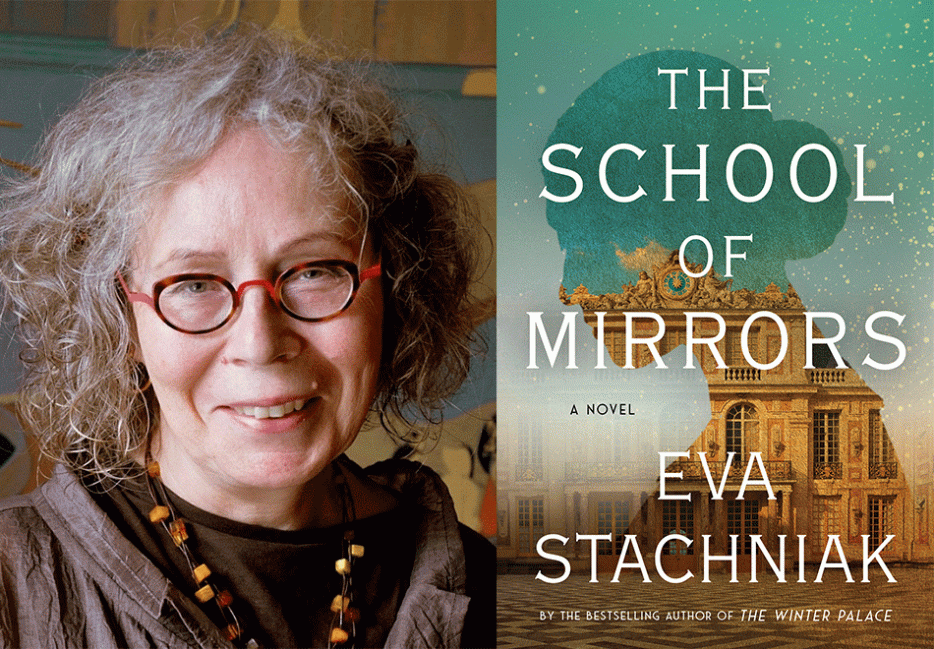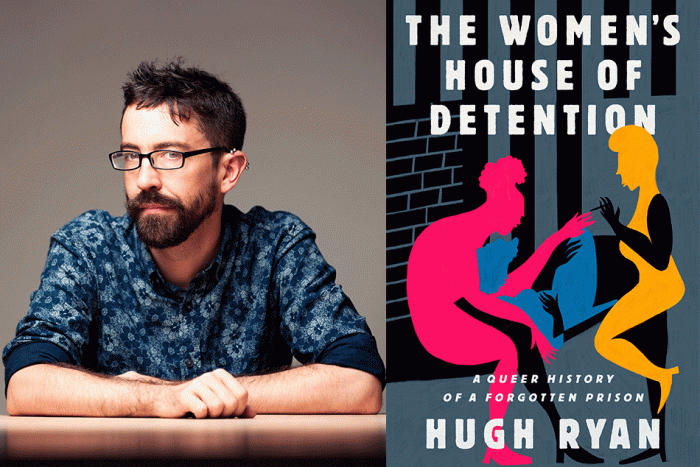Women’s bodies have long been used as tools of conquest, in displays of dominance and acts of war, their voices unheard.
These are silences that Eva Stachniak opens up with her latest novel, The School of Mirrors (Doubleday). Véronique and Marie-Louise—mother and daughter, both from the poorest class, with little agency of their own—live in 18th century France, a place where a debauched king can keep a stable of very young women in a house known as Deer Park, some who haven’t yet bled, for his personal pleasure. It’s an historical precursor to Epstein’s compounds and others like them: impoverished young women are lured with false promises of work that would improve their economic situation but become sexual playthings for the king instead. Often, as with Marie-Louise, the king’s agent secures these women with only parental consent. The young women themselves are never even asked.
Although women’s sovereignty over their own bodies continues to be threatened worldwide, women have eked out ways to exercise agency and help each other. In The School of Mirrors, Marie-Louise is taken under the wing of France’s first midwife and becomes one herself. The novel is deeply feminist in inception and execution, a counter-narrative that gives voice to the powerless, whose stories are rarely a matter of historical record.
Christine Fischer Guy: How and when did you find out about Deer Park? Was it the inspiration for this novel, or did it come later in the process?
Eva Stachniak: It was both the beginning and the inspiration.
Reading the The Private Memoirs of Madame du Hausset, Lady’s Maid to Madame de Pompadour, I came across a scene in which Madame de Pompadour, King Louis XV at her side, summons Madame du Hausset and orders her to take care of a young lady until her confinement and make arrangements for the baby’s baptism. From the conversation that ensues, it becomes clear that the king is the father of the child, and that the young lady doesn’t know it. “She and others like her” have been told that their lover is a Polish count, a distant cousin of the queen, who keeps an apartment at Versailles.
That very phrase, she and others like her, was enough to make me dig deeper and discover Deer Park, a secret house in the town of Versailles where royal enablers kept young, pretty, lower-class girls for the king. The house, supervised by Madame de Pompadour but run by the king’s valet de chambre, was an elaborate and well-functioning establishment. The girls were told that they were trained to become ladies’ maids and thus improve their station in life. Most were dismissed after one or two “visits” with their “benefactor.” A few caught his fancy and stayed longer. I tried to find out who they were and what happened to them in the end, but the voices of the powerless rarely merit more than an occasional record. I’ve found a few names, learnt that Deer Park “bastards” were always given to foster parents, that the palace paid for their upkeep and set them up in life.
This is how the novel began, with an image of a young pregnant girl, a child she will give birth to, and the royal courtiers who make sure neither will ever cause their royal master any trouble.
This scenario puts me in mind of “the virgin cure,” an insidious myth that gained prominence in 19th century England: sexual relations with a virgin could cure a man of disease (then, syphilis). It persists in various forms throughout the world, a tragedy that leaves a trail of human wreckage: men of means use a very young woman’s body as they wish, without regard for her personhood.
“The virgin cure” is an excellent example. Men of means and thus impunity usurp the right to use the female body as an object, a possession devoid of agency and feelings. We are still nowhere near being free from it. I don’t just mean the cases of Jeffrey Epstein or Harvey Weinstein, either. It is enough to take a closer look at any war—most recently in Ukraine—to see how quickly women’s bodies become objects of revenge, a weapon of terror meant to dominate and humiliate the enemy.
Sexual violence exerts one more terrible price. Silence. Silence forced by shame, by fear of reprisals, by the wish to spare the loved ones from pain. Silence of the victims and the perpetrators, of women and of men. Silence which seeps through generations, silence we inherit as children and carry with us all our lives.
Any family who has been through the terror of war carries these silences with them in various ways, as recent work on intergenerational trauma shows. When a woman’s body is used as a tool of war, she is silenced, as you say. Historically, the fallout—in my grandmother’s case, headaches, bad stomach, nightmares—didn’t have a name, and yet generations after carry the effects of PTSD in their own bodies. We are only starting to understand that these unresolved, unacknowledged traumas are carried forward on a cellular level in future generations.
Although women’s bodies are used as tools of war, they haven’t historically been considered as equal value to men’s bodies, have they? Even within legitimate relationships, a woman’s pleasure was never a requirement in sexual relations. The young women in King Louis’s stable didn’t give consent; the act itself wasn’t even named. That’s a kind of erasure, too.
In your research, did you find any examples of women who spoke up? What were the consequences?
The young women recruited to Deer Park were never asked for consent. Their parents were asked, and they made their own calculations. In The School of Mirrors, the Widow Roux, riddled with debts, believes that her three sons trump one daughter. All other arguments were a luxury she could not afford.
Yes, there were women who spoke up. One nameless Deer Park girl stubbornly maintained that the king of France was the father of her child, until a few weeks of “treatment” in a mental asylum forced her to change her mind. One anonymous girl escaped with the help of her sweetheart. There was also Marie-Louise O’Murphy who, emboldened by the king’s liking of her, tried to win the Versailles game by trying to oust Madame de Pompadour herself, famously asking the king, “What do you still want with the old cocotte?” Louis XV dropped her in an instant and had her married off to an impoverished aristocrat.
The game was rigged then and it is rigged still. As Melissa Febos notes in Girlhood, her changing girl’s body had the “power to compel but not control.” And then she adds: “There is no good strategy in a rigged game. There are only new ways to lose.”
Even within their limited scope of power, women have shown resourcefulness and ingenuity, exercising what little agency they had to help each other. I read accounts of women in my family’s ancestral village helping each other find food for their children under the cover of the night when Stalin’s occupying soldiers took the lion’s share of the crops for themselves and the village men were away in Russian work camps.
In The School of Mirrors, Marie-Louise, fierce and strong and intelligent, crosses paths with a midwife who changes her life. France’s first midwife, who we glimpse in the novel, was a force of nature who invented a “birthing machine” for student midwives and won a commission to train others by showing it to the same debauched king. In the words of Mme du Coudray’s biographer, “hundreds of letters existed, to her, about her and by her… There are hardly any women, especially in the 1700s, who left that kind of paper trail.” Du Coudray not only helped improve the lives of other women but carved out a place in history for herself, all from within a very limited scope of power. How she sold King Louis on the idea of funding the training of midwives all over France? By describing the French babies that would be saved. Brilliant and subversive, wasn’t it?
Did finding the record of Mme du Coudray change the course of the novel?
Yes, in the most fundamental way.
Angélique Marguerite Le Boursier du Coudray hijacked the second part of The School of Mirrors. A licensed midwife, a proud professional woman aware of her self-worth, a relentless advocate for women’s health, she fought to improve both natal care and to reduce infant mortality. And in contrast to the Deer Park girls who had no agency or voice, she was a woman who would not be silenced.
Madame du Coudray’s biography The King’s Midwife provided the basic facts. Single and of unknown parentage, she practiced as a licensed midwife in Paris in the 1740s and ’50s, rising to the position of head midwife in the Hôtel Dieu, where approximately 1500 babies were delivered each year. Faced with the realization that Parisian high standards of natal care were inaccessible to poor women in the provinces, she obtained royal funding and patronage for her obstetrics course with the help of a teaching tool she had invented, the “birthing machine.” Between 1760 and 1783, she criss-crossed provincial France training thousands of young peasant women in the art of midwifery. She also adopted and raised an orphaned peasant girl, Marguerite Guillaumanche, later Madame Coutanceau, who carried on her work well into the 19th century.
The “machine” speaks of Madame du Coudray’s resourcefulness and ingenuity. It is a curious object: a cut-off model of a female torso, a stuffed pregnant belly designed to give the students the illusion of delivering a baby. It makes use of ordinary, easily accessible materials. An internal wicker frame is covered with straw or upholstery. Sponges imitate flesh. An additional layer of durable linen imitates skin. The vessels hidden inside the belly hold fluids which can be released to imitate breaking waters or internal bleeding. The baby mannequin has an open mouth so that a student could practice the well-proven maneuver for breech births which demanded inserting two fingers into the baby’s mouth.
How many lives had she changed for the better! Not just the lives of mothers and children, but also the lives of thousands of young women from the provinces who received her precious gift of education. The gift that gave them a chance to exercise power over their own lives.
All I needed for The School of Mirrors was to imagine women like her and let them lead me.
Like Mme du Coudray herself, Marie-Louise breaks the poverty cycle in a system set against her. Unlike her mother, she escapes the silencing imposed by the king. I’ve been thinking a lot about the role of silence as I work on my own second novel, about music and silencing under a Russian regime. Silence is violence. The seat of power can be conceptualized as one’s voice, however expressed, whether through the vocal cords themselves or through one’s work. Within the scope of her limited powers as a poor young woman, Marie-Louise gains a voice of her own.
I’d like to circle back to your decision to open up historical silences by introducing this counter-narrative to the official version of French history. In an interview, you said, “As a child, I quickly calculated: to be a grandmother I have to live through two world wars, to be a mother, through one World War and one Nazi occupation.” How did the women in your personal history act on the story you tell in this novel?
The women who raised me, my mother and my grandmother, raised me in Communist Poland, in the aftermath of not just a devastating world war, but of what historian Timothy Snyder so aptly called the “bloodlands,” Hitler’s and Stalin’s killing fields.
As far back as I remember, war ruins have been around me everywhere. The houses that survived still had inscriptions in Russian: Min nyet. No mines. There were only two kinds of time: pre- or post-war. The words World War II meant that there must have been World War I and that there could be World War III. Stalin and Hitler were dead but their legacy was still very much alive.
At dusk, after all the work was done, my widowed grandmother would sit by the kitchen window, staring into the distance, turning the rings on her gnarled fingers. Her silence frightened me. I remember her startled eyes when I approached, her blue unseeing eyes, welling up with tears. If I asked what she was doing, she would say she was praying for the living and the dead. Every time she heard me laugh, she would tell me to stop, for I would soon cry. Once when I was playing with stones, she snatched them from me and threw them away, screaming, “Do you want your life to be as hard as mine?”
My mother did not believe that playing or not playing with rocks mattered. Refusing to yield to despair, she pushed the war past behind her, became a paleontologist, a professional woman, an outspoken expert in her field. She too warned me, but her warnings were of a different kind. Wars always brought out the worst out of humanity. Men were wolves to each other. Give them half a chance to drown you in a spoonful of water, they will. Then she made me concentrate on what was still possible. “If they close the door, get through the window. Find a way. You don’t know how? Figure it out.”
I thought of her as fearless, invincible, and yet she too refused to speak about her own experiences during the war or the political reprisals that followed. I knew she had been imprisoned as a member of the anti-communist underground, but only because she never let me close the door of a room she was in. “I’ll tell you one day, when you grow up,” she might say to fend me off when I wanted to know more, but mostly my questions would annoy her. We were living under a totalitarian regime; informers were everywhere. A child could be easily manipulated. Not knowing was a form of protection.
Nature abhors a vacuum. My mother’s silence, even more than my grandmother’s, had always taunted me. It turned me into an expert in reading clues that slipped through her defences, eyes turned away too quickly, the tensing jaw, the unexpected anger in her voice. Many years later when, ravaged by Alzheimer’s, she no longer knew I was her daughter, she pointed at a bullet-riddled wall of a building we passed by and said: “These were terrible times. I know you want me to tell you what has happened, but I won’t.”
A missing story becomes conspicuous in its absence. A story refused, a conversation that did not take place, leaves a wake of loss behind it. I mourn the intimacy we could have shared, the comfort we could’ve given each other, but I’m her daughter through and through. I too turn to what is still possible.
The School of Mirrors emerged from my personal memories of growing up with women marked by silence and loss. Their fear and their insistence that women choose silence for many reasons, not just shame and fear, but also love and the desire to protect those around them. Their conviction that even if the ravages of silence cannot be reversed, life is resilient and thrives on hope and that lost voices can be regained in spite of everything that has conspired against them.
The loss of memory did not make my mother forget her determination to keep her secrets, but it did turn the formidable professional woman I had known all my life into a spirited teenager who would assure me she loved me because we were so happy together, or a thoughtful friend offering the greatest gift of all: empathy and acknowledgement of my pain.
“You say you are my daughter. I don’t know how this could be possible. But if you are right, it must be terrible for you to know that your own mother cannot recognize you.”
That moment found its way into The School of Mirrors.
That scene was very moving, perhaps more so as my own mother has been recently diagnosed with Alzheimer’s. She still recognizes me, but I know the day will come when she won’t. And then there’s the other sort of forgetting, which isn’t forgetting at all but the desire to forget traumatic times or dissociate from them entirely. I grew up with the laughter admonishment, too, and it went “Laugh before seven, cry before eleven.” The subconscious life advice transmitted in that aphorism: one must never forget that tears or disappointment are just around the corner.
My grandmother wouldn’t talk about the time that Stalin’s soldiers occupied their village, except once, when I pressed her. “The doctor made sure no babies were born,” she said, and then would say nothing further. That sort of elliptical comment was meant to shut the conversation down but did the opposite—it became a catalyst for my research and imagination that fuels my work.
When your mother said, “You want me to tell you, but I won’t,” did it have a similar effect? Did it become a reason for the decision you made to let the women finally tell their story? I’m thinking of your wonderful line “The dead, once wakened, may not stay silent.”
It did. I was never old enough to hear it, or she was never ready to speak. Was it the fear of her own reaction or mine? Why couldn’t we talk about it? What would’ve happened if we did? There is enough force in it to make me imagine and probe. This mother/daughter conversation I never had seeped into The School of Mirrors but in some ways, it underlines all my writing. I know that it is the same for you, and that this phantom conversation will continue to frustrate and inspire you.
All my writing comes from the deep need to break this chain of imposed silence, to restore the voices that could not or would not speak. It is no coincidence that I became a writer only after I emigrated from Poland, and that I became a writer in English rather than in my native Polish. My Canadian voice is much bolder, not as susceptible to cultural warnings of what can or cannot, should or shouldn’t, be said. Polish secrets and obligations are not Canadian secrets. Distancing myself from language and place gave me the emotional freedom to explore and restore what might have been much harder or impossible to probe if I had never left.






